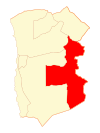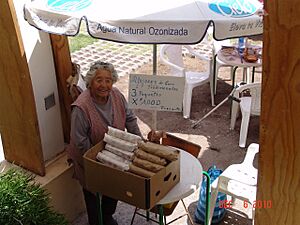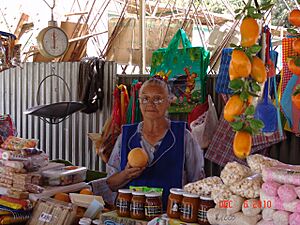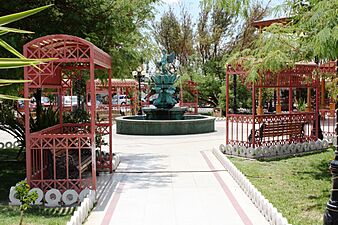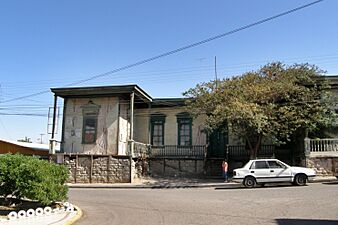Pica, Chile facts for kids
Quick facts for kids
Pica
|
|||||
|---|---|---|---|---|---|
|
Town and Commune
|
|||||

View of Pica town and oasis in the foreground from the southeast.
|
|||||
|
|||||
| Country | |||||
| Region | |||||
| Province | Tamarugal | ||||
| Government | |||||
| • Type | Municipal council | ||||
| Area | |||||
| • Total | 8,934.3 km2 (3,449.6 sq mi) | ||||
| Elevation | 1,106 m (3,629 ft) | ||||
| Population
(2012 Census)
|
|||||
| • Total | 4,013 | ||||
| • Density | 0.44917/km2 (1.16334/sq mi) | ||||
| • Urban | 4,674 | ||||
| • Rural | 1,504 | ||||
| Sex | |||||
| • Men | 4,569 | ||||
| • Women | 1,609 | ||||
| Time zone | UTC-4 (CLT) | ||||
| • Summer (DST) | UTC-3 (CLST) | ||||
| Area code(s) | (+56) 5 | ||||
Pica is a Chilean town and commune located in the Tamarugal Province of the Tarapacá Region. It is found in the middle of the Atacama Desert, a very dry place. Pica is special because it is an oasis, which means it has a green area with water in the desert.
The town is famous for its small, sour limes known as Limón de Pica. Pica also has a natural hot spring with warm water (about 40 °C). This makes it a popular place for people to bathe and relax in the desert. Pica offers hotels and other basic services for visitors. It is located about four kilometers northeast of the nearby oasis village of Matilla.
Contents
History of Pica Oasis
Pica has a mild microclimate, which means its weather does not change as much as in other deserts. The town has very old origins, dating back to before the arrival of Europeans. It was an important stop for travelers going between the coast and the high plains (the Altiplano) during the time of the Inca Empire.
Mining and Growth
Pica became more important between the 17th and 19th centuries. This was because of mining in nearby areas. First, there was silver mining from 1718 to 1790. Then, from 1830 to 1870, people mined for saltpeter, which was used to make fertilizer and explosives. After the War of the Pacific (1879–1883), Pica became part of Chile.
Water and Farming in Pica
Pica once had a large system for bringing water to its farms. This system used puquios, which are underground channels. The shafts (or openings) of these channels are called socavones. In 1918, a geologist named Juan Brüggen found 23 socavones in the Pica oasis. However, these have since been left unused due to changes in the economy and society.
Water Challenges for Farmers
These socavones used to carry water from the Pica Aquifer to the oasis. Like many oases, one of the biggest problems for farmers in Pica is not having enough water. Most farmers in Pica own small plots of land, less than five hectares (about 12 acres). This small size makes it hard to sell their products widely.
Farmers Working Together
To help with these challenges, farmers have started to work together in cooperatives. For example, six producers, who grow about one-fifth of the oasis's crops, are part of the Oasis Pica Coop. As of 2019, this group was working to get their products certified as organic. They also work to protect the special name for their famous limes, Limón de Pica, which has been officially recognized since 2010.
Population of Pica
According to the 2002 census by the National Statistics Institute, Pica covers an area of 8,934.3 square kilometers. It had 6,178 people living there at that time. Of these, 4,569 were men and 1,609 were women.
Most of the people, about 4,674 (75.7%), lived in urban areas (towns). The remaining 1,504 people (24.3%) lived in rural areas (the countryside). The population of Pica grew quite a bit between 1992 and 2002, increasing by 45.9% (3,666 people).
How Pica is Governed
Pica is a commune, which is a local administrative area in Chile. It is managed by a municipal council. The council is led by an alcalde (mayor), who is chosen directly by the people every four years.
Gallery
See also
 In Spanish: Pica (Chile) para niños
In Spanish: Pica (Chile) para niños



